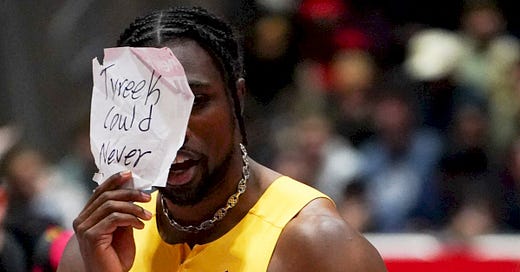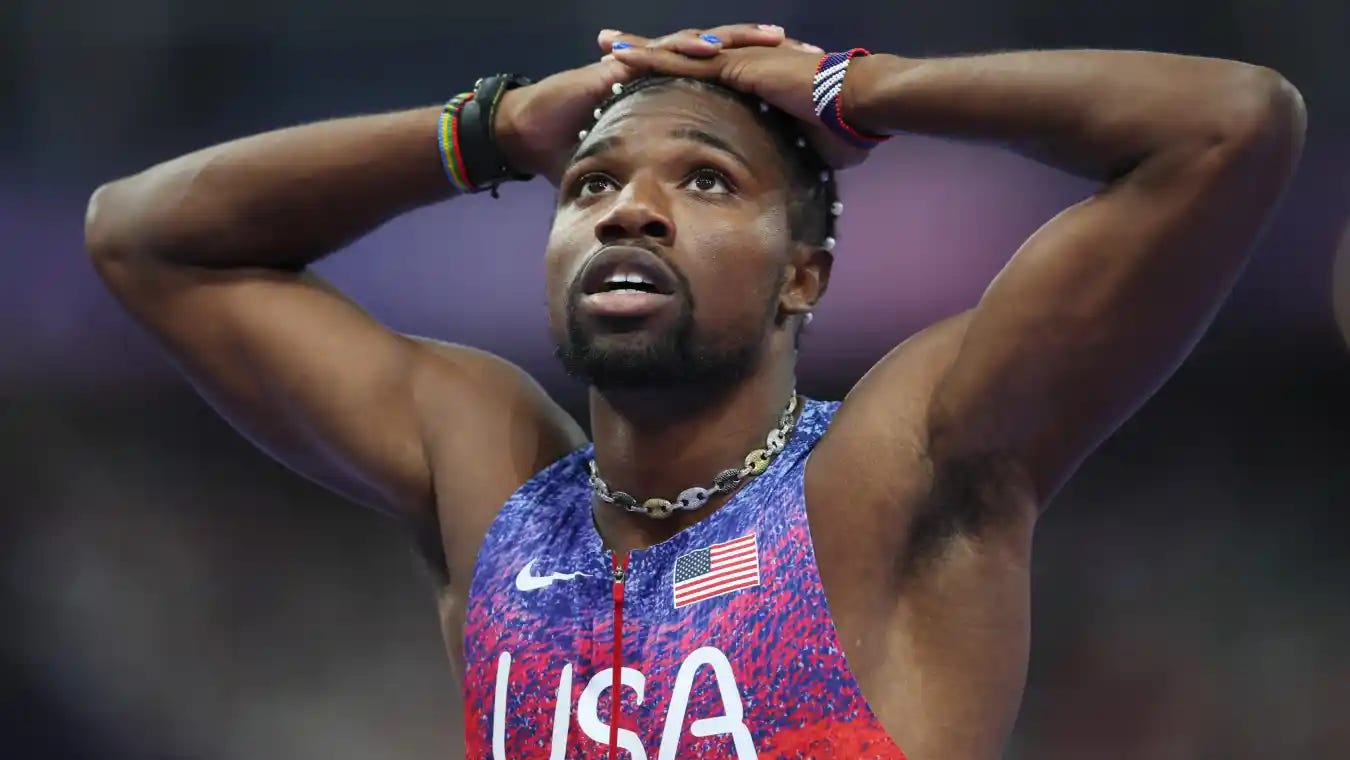✍️#7: Noah Lyles vs. Tyreek Hill: Nobody Wins.
A commentary on blending two sports through the shared language of speed and how context is everything when trying to build a fanbase.
A lot of thanks here should be given to David Callahan, Co-CEO of UltraSignup, who posted this prompt on his LinkedIn recently to spark conversation.
HOW DID WE GET HERE
Noah Lyles breaks the tape of his fourth New Balance Indoor Grand Prix 60m title and leaps vertically up the padded wall, surveying the crowd before he lands back on the track. He confidently rips his bib off of his chest and turns it around for all cameras to zoom in and capture the moment. In his handwriting, it reads:
“Tyreek Could Never”
After some playful back and forth on social media, Olympic 100m Champion Noah Lyles and Miami Dolphin’s Receiver Tyreek seem to have escalated their playful feud and the pot has boiled over — they’re allegedly racing to decide who is the fastest for once and for all.
THE AGE-OLD DEBATE
Raw speed has long been a topic of debate and intrigue across sports. It seemingly is the common denominator across the court, pitch, track, and arena. We’ve seen influencers like IShowSpeed throw their hat in the ring to show off how they can keep up with the greats. In the more traditional sport comparisons, articles have been written to contextualize the speed of top soccer star, Kylian Mbappé.
Perhaps the most transferrable head-to-head was in 2020 when NFL Star DK Metcalf comepeted in the Golden Games to qualify for the Olympic Trials. Metcalf, seemingly with little to no specialized training on his start, drive, and finish phase, registered for the 100m in a sanctioned race — a pure option to compete. He ran an impressive 10.36, but missed the qualifying standards and finished in the bottom third of participants.
What was missing? Spectacle.
While NBC pushed a this showdown in media outlets and social media, the field lacked pedigree to contextualize the speed. In other words, there were no “names” in DK’s heat to see how he really stacks up.
WHY IS IT IMPORTANT?
Pundits spend time talking about how to build the sport, bring in non-endemic sponsors, create heroes in sport, and bring more money and more opportunity to the athletes. They have suggested building premier racing platforms like the Diamond League, new competition formats like Grand Slam Track, and massive content/media plays like Netflix’s SPRINT. The are all underscored by an attempt at cultivating one thing: Awareness.
A LOSE-LOSE SITUATION
A loss for Noah and a loss for Track and Field is likely due to the context of fandom.
Noah’s, in a sense, “punching up” to NFL fans, meaning that he’s proving himself to the bigger audience who may not necessarily care about how fast he is at all. In other words, they were never clamoring for Noah Lyles to prove himself. In contrast, Tyreek is “punching down” to track fans, meaning that he doesn’t need track and field fans to validate him in sport — he’s already laughing all the way to the bank. It’s also worth noting that it’s not even RUNNING fans because unfortunately, Noah isn’t a household name amongst runners at this time. Unfortunately, you could likely walk through a marathon corral or the start line of an ultra an ask them who Noah Lyles is and I’m sure you’ll get mixed responses.
From the argument above, the awareness building, appeal and validation is to the NFL fan — they have more viewing and buying power, there are more of them, and they have a greater overlap with the general sports audience when compared to track fans.
Accordingly, Tyreek on a track isn’t accessible enough to the average viewer, especially to an NFL fan. NFL fans understand 5-yard increments in a game setting and a 40 yard dash in the combine. Even the concept of METERS is foreign and this creates yet another obstacle for the key viewer to care or understand.
HOW TO MAKE IT WORK #1: HACK THE COMBINE
While unlikely due to sponsorship issues, what would do more for Noah in the eyes of an NFL fan is putting Noah through the NFL combine. Heck, you could even have high jumpers do the vertical test, triple and long jumpers do the broad jump! They can hopefully set the athletic standard in the disciplines and contextualize their skillset in the arena NFL fans understand.
Imagine this, you could roll out a social media series of track and field specialists competing in these disciplines and then they can help the incoming draft class in preparing for these challenges.
HOW TO MAKE IT WORK #2: NFL TAKEOVER
If track and field wanted to win the NFL fan base, they need to bring several NFL stars on the track to contextualize the event itself with potentially one sprinter as a measuring stick. Imagine the top 5 NFL Athletes with the best 40-yard dash times in 2025 lining up against Lyles in a 100m. A full field of NFL players provides the context of comparison that we lack currently. In other words, an NFL fan may understand and care what 100m speed looks like if Travis Hunter is racing Tyreek Hill and DK Metcalf. And concurrently, they may care more about how they stack up to a track athlete if more NFL athletes are racing them.
Imagine a social media series of track and field coaches and athletes guiding top NFL talent in how to be even better in the sport. It could even further cement the credibility of the track and field personalities if the performance of the NFL athletes improves! We saw a GLIMMER of this in Shilo Sanders sharing content around his preparation of running a 40-yard dash for NFL combine stats and receiving additional input from sprinters. This was so cool!
TLDR: I’d hedge the bet that if track and field wants to win over the NFL fan, they need to either own the arena (the combine) or activate several stars in order to contextualize the athletic feat of track in itself.
SMALL BRAND MENTALITY SLINGSHOT
I’ve had the pleasure and privilege of connecting with individuals who aspire to build their careers in the outdoor industry and to flourish within it. In this segment, get to know and connect with them to slingshot their personal development and see what they’re up to!
Meet Adrián Alamos
“Hey! I’m Adrián, but most people in the running world know me as Chalo. I’m a filmmaker and photographer from Mexico City who didn’t take the “creative path” in the textbook way. I didn’t study film or photography mostly because my parents didn’t think it was a real career. So I went with marketing.
For years I worked in creative teams for brands and agencies, always with the itch to do something that felt more like me. I tried building projects with partners, failed a few times, until one day I stopped waiting for the perfect moment — and just started shooting what I love most: running.
My earliest stories came from the streets of CDMX, capturing the people I ran with, starting with my crew, Clique. Pato, the founder, gave me a shot and from that small window, a new world opened up. That’s how Chalo Media was born: a space where sport meets emotion, and visuals feel personal, not produced.
Later, traveling to cities like Los Angeles, Chicago, and Boulder, I got to experience different running cultures, from underground relays to community-led crews. But not just that. I also connected with photographers, creative directors, and artists who reminded me that this world is bigger than we think, and that storytelling through sport can be a powerful form of art and identity.
In Mexico, photographers and filmmakers are often seen as just executors. My goal is to challenge that. I believe we’re not just holding the camera, we’re shaping the vision.
My dream is to work on global campaigns where the perspective of a Mexican creative isn’t an exception, it’s part of the story. I want to be in the room where the ideas are born, not just where they’re captured. I believe in stories that run deep the ones that move, sweat, and stay with you long after the finish line.
Let me know if you need anything else, happy to send over a headshot or tweak anything if needed. Grateful to be included, really.
Un abrazo,
Adrián”
Like what you’re reading? Buy me an NA Beer below to keep me fueled up!











Chalo!!